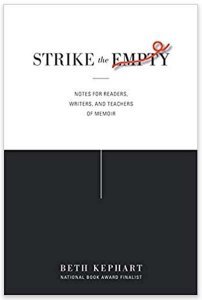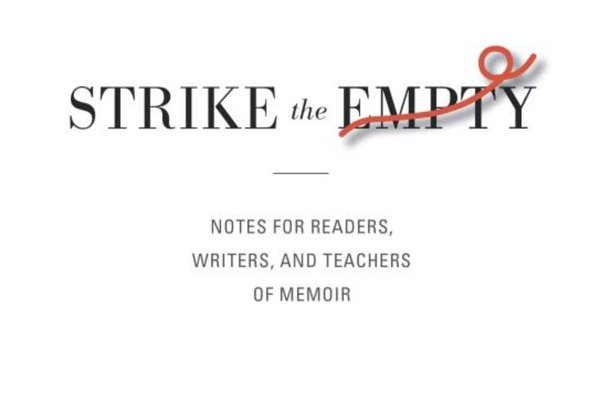Beth Kephart’s new book on memoir
extends her ongoing conversation
By Richard Gilbert, WTP Contributing Editor
STRIKE THE EMPTY: NOTES FOR READERS, WRITERS, AND TEACHERS OF MEMOIR by Beth Kephart (Juncture Workshops, 2019). 185 pp, $12.00.
 Let’s start with the title, a very good place to start—bemused, as you are, by what “The Empty” is and how to spot it, hunt it down, slay it. Beth Kephart explains in the introduction to her latest book, Strike the Empty: Notes for Readers, Writers, and Teachers of Memoir:
Let’s start with the title, a very good place to start—bemused, as you are, by what “The Empty” is and how to spot it, hunt it down, slay it. Beth Kephart explains in the introduction to her latest book, Strike the Empty: Notes for Readers, Writers, and Teachers of Memoir:
Make the story bigger than you are by making it more true, and, always, strike the empty—that meaningless phrase, that excessive detail, that tired trope, that obvious epiphany, that unmurdered little darling.
Oh, that’s all. What clarity, what relief!
Not so much of either, actually, at first. But how bracing to hear Kephart’s confident voice in your ear, to encounter her apt metaphors, to witness her clipped precision, to savor what she quotes. What you realize, chasing Kephart’s meaning, is that this is a book about the memoirist’s sensibility. Enmeshed in her sensibility, you may want to borrow it, to skip the bother of forging your own. But that won’t do.
So, how? Write and read. Always: read. That’s her enduring message. And like all effective teachers, what Kephart points toward and what she avoids, or barely mentions, give her students as much of a map as anyone can get for something as protean as art. I don’t always thrill to what Kephart loves, or agree with what she dislikes. But her authority, as a practitioner and reader, is such that I question myself. That doubting, too, is part of discovering and refining one’s taste, of joining the conversation.
Here is Kephart on the early steps of her apprenticeship:
For the longest stretch of my early life, all I had, when it came to words, was poetry. My poems were bad poems. They were mistaken. Sonnets, clichés, mawkish disasters. Who did I think I was? Why did I write these complicated lines? Anyone but me could tell that these poems were just no good.
Yet I persisted; I believed I had no other choice. I was a kid who felt with plenitude, who walked outside the lines. Weather, music, movement, injustice were my themes. Blindness, sunsets, lonesomeness became my subjects.
Poems became my memoirs.
In the growing-up years, I learned to leave poetry to the poets….
Reading her, you see she hasn’t left poetry entirely. Poetry’s precision and its indirect approach to truth—groping sideways toward it, showing it but not necessarily stating it—stamp her prose; her leaps and metaphors can be at once seductive and elliptical. But she does try to tell you what she means. She’s all for the writer’s burning truth, for instance, as long as the writer’s imagination includes others:
Your mother might have said a lot of things that hurt you, but she came from somewhere, she had a history, she was shaped by some things out of her control, she was haunted. What do you know about that haunting? How hard have you tried to understand her? Who was she when she thought she was alone? What evidence of another possible self did she leave behind? What happens when you study her photographs, and what happens when you focus, even briefly, on her own vulnerabilities? . . .
Make yourself capable of listening to, and receiving, the cracked, hard, lovely stuff of other people’s lives.

Strike the Empty, Kephart’s twenty-third book, is divided into three parts: the first two, “Notes” and “Upon Further Consideration,” are concise essays she has published in literary journals and in her monthly Juncture newsletter for memoirists; the third, “The Memoirs and the Memoirists” includes short statements by writers about their process, followed by Kephart’s succinct commentary.
Dipping into the book a bit at a time, the natural way to read such a disparate collection, can blunt the force of Kephart’s convictions. In addition to her aversion to anything that smacks of settling scores, she believes in form—in the rigor of discovered, chosen, refined, nimble structure. She doesn’t plod, and abjures plodding stories. You know, the chronological defaults many of us write as beginners and even later. She believes:
Meaning lives in structure. In the deliberately juxtaposed. The unexpected tangent. The pause, resume, repeat, refer, foreshadow, lately remember, reconsider, now return. The quest to find out. The verse and the song.
As always, Kephart gives examples from memoirs she admires, often those that startle with their form. But the slippery subtleties in nonfiction forever remain immense—here, the inherent but initially unapparent relationship between persona and structure. The neophyte memoirist may see and seize upon the vivid scene of someone’s tumultuous past event, overlooking what’s even more crucial in memoir, the reflective, truth-seeking narrator. Is a fly on the wall really telling this story? Or is it someone looking back from another time and place, someone with other lives that inform her telling? Kephart’s foremother Virginia Woolf codified this principle in her great, unfinished memoir “A Sketch of the Past,” collected in Moments of Being:
[I]nclude the present—at least enough of the present to serve as a platform to stand upon. It would be interesting to make the two people, I now, I then, come out in contrast. And further, this past is much affected by the present moment. What I write today I should not write in a year’s time.
To heed Kephart is to take control and assume responsibility, at some point, for all of this and more. Here she is in her chapter “Make it Urgent: On Managing Tenses”:
Every choice opens doors and limits us. Every choice must be deliberate. Reflective distance? Immediacy? The facts or the feelings?
Choose the tense. You choose the story.
Kephart’s emphasis on the large-hearted shaper partly explains her motif of truth in memoir. If there’s a present you, which means, in part, someone treating readers as friends, you can tell readers when you’re imagining and when you’re fairly certain. When a character’s “double chin and bright red scarf and knobby knuckles” existed, fine, says Kephart, but you “don’t have to make things up about other people for me to maintain my interest in you.”
The number of pages I dog-eared in Strike the Empty indicate this is a book to read again. Anyone completely new to the genre, however, might start with her Handling the Truth: On the Writing of Memoir—though, in Kephart’s way, that’s also more of a meditation than strictly a how-to book. She considers a memoir to be the “start of a conversation,” something ultimately larger than the writer because its concerns are universal; readers carry it into their own ongoing conversations about what we’re doing here. Strike the Empty models this generous notion, and it shows her voice regarding the genre is indispensable.
Richard Gilbert currently reads, writes, and teaches in southwestern Virginia. His book Shepherd: A Memoir was a finalist for the Ohioana Book Award, and his essay “Animals Saved Me” won the 2017 Hunger Mountain Creative Nonfiction Prize. He writes about writing at http://richardgilbert.me/.

